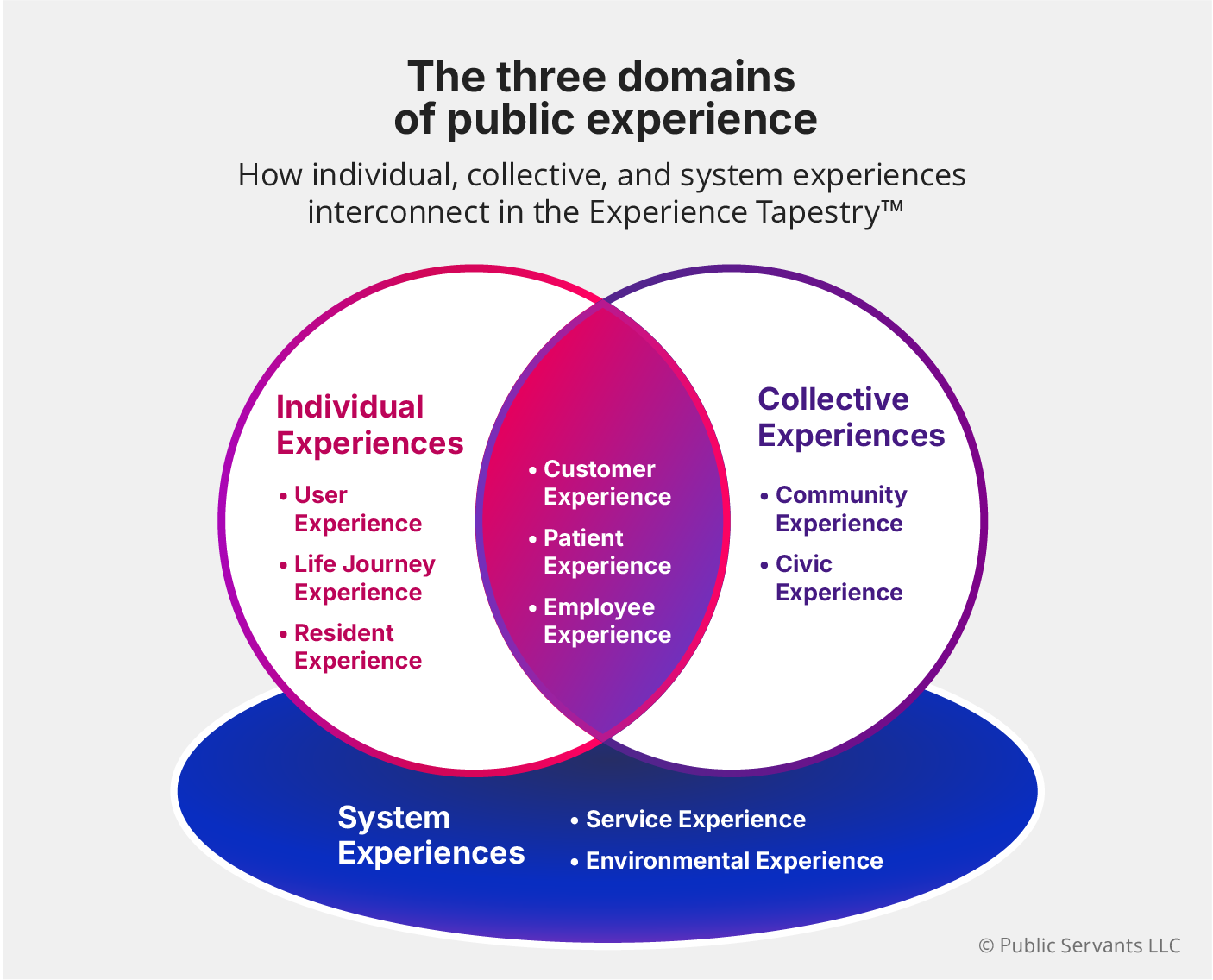Experience Tapestry™
How public systems weave together the experiences that shape civic life
Public systems don’t just deliver services, they create experiences. Every form filled out, every bus ride taken, every public meeting joined contributes to how people understand and trust government.
We call this the Experience Tapestry™: the interwoven layers of individual, collective, and planetary experiences that make up civic life. By looking at these layers together, we can see how trust is built—or broken—and design more effectively for the public good.
Why Experience Tapestry™ matters
The Experience Tapestry™ is made of ten interconnected layers of public experience.
Too often, governments design policy and services in silos. One team works on digital usability, another on patient care, another on community engagement. Residents experience them all at once—and what feels like a small gap internally can become a gaping hole in someone’s life.
The Experience Tapestry™ framework helps us step back. It reminds us that these experiences are interconnected, and that designing for one layer without considering the others risks unraveling the whole.
The ten experiences in the tapestry
Each strand of the Experience Tapestry™ captures a different dimension of civic life. Explore each of them for a more complete picture.
We’ve numbered them here for clarity, but the order isn’t a hierarchy or a starting point. You can explore them in any sequence—together they form the whole tapestry of public trust.
User Experience (UX): Clarity in everyday interactions with tools and systems.
Customer Experience (CX): Coherence across the full journey of a service.
Service Experience (SX): The functioning of services end-to-end, from eligibility through delivery.
Patient Experience (PX): Humanity and dignity in healthcare.
Employee Experience (EX): The conditions that support public servants in delivering services.
Resident Experience (RX): The public’s overall sense of fairness, respect, and trust.
Community Experience (ComX): How groups and neighborhoods experience systems together.
Life Journey Experience (LJX): How services support people across major milestones and transitions.
Civic Experience (CivX): Belonging and participation in democratic systems.
Environmental Experience (EnX): The planetary context that underpins all other experiences.
Each of these entries is explored in depth in our Civic Glossary series.
Note: You may also see Product Experience (ProdX) discussed in civic design contexts. We address it within our UX and CX entries, since in public systems it’s less a standalone strand and more a component of those experiences.
The three domains of public experience
Venn diagram of the Experience Tapestry™ showing Individual Experiences (User Experience, Life Journey Experience, Resident Experience), Collective Experiences (Community Experience, Civic Experience), their overlap (Customer Experience, Patient Experience, Employee Experience), and System Experiences (Service Experience, Environmental Experience) beneath both.
While each strand has its own definition, together they cluster into three domains that reveal how experiences relate to one another across the Experience Tapestry™.
Individual experiences (User Experience / UX, Life Journey Experience / LJX, Resident Experience / RX) focus on personal interactions with tools and systems.
Collective experiences (Community Experience / ComX, Civic Experience / CivX) describe community-level dynamics.
Overlapping experiences (Customer Experience / CX, Patient Experience / PX, Employee Experience / EX) connect individual and collective needs, where trust is most visible.
System experiences (Service Experience / SX, Environmental Experience / EnX) shape the infrastructure and environment that sustain both people and groups.
Participation as a thread through all experiences
Participation is the thread that strengthens every layer.
No matter the strand, the most important thread running through the Experience Tapestry™ is participation. Residents, patients, employees, and communities must be engaged in shaping their experiences. Research, co-design, and feedback aren’t extras—they’re what make these systems credible, effective, and worthy of trust.
What it adds up to
Trust is built when the whole tapestry holds together—not just one part.
The Experience Tapestry™ shows us that experiences aren’t isolated. They build on one another: poor Employee Experience (EX) undermines Resident Experience (RX), gaps in User Experience (UX) weaken Customer Experience (CX), and neglect of Environmental Experience (EnX) erodes trust for generations. Conversely, when each layer is strong, they reinforce each other—weaving a system that supports dignity, fairness, and trust.
Public Servants’ lens
At Public Servants, we believe trust is the new infrastructure. By understanding and improving the Experience Tapestry™, we help governments and nonprofits deliver services that don’t just work—they uplift.
Explore the Experience Tapestry™ with us
Public Servants partners with agencies and nonprofits to strengthen public experiences at every level.
Contact us to learn how we can help weave trust, dignity, and equity into your systems.
Begin your journey through the Experience Tapestry™ with User Experience (UX)—where public trust begins: clear, usable interactions.


